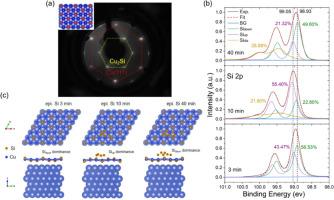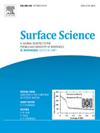Growth and electronic structure of the nodal line semimetal in monolayer Cu2Si on Cu(111)
IF 2.1
4区 化学
Q3 CHEMISTRY, PHYSICAL
引用次数: 0
Abstract
Cu2Si, a single-layer two-dimensional material with a honeycomb structure, has been proposed to have Dirac nodal line fermions. In this study, the synchrotron radiation X-ray photoelectron spectroscopy, ultraviolet photoelectron spectroscopy, and angle-resolved photoemission spectroscopy (SR-XPS, SR-UPS, and SR-ARPES) techniques were used to investigate the dynamic process of in situ deposition of single-layer Cu2Si on a Cu(111) crystal surface via molecular beam epitaxy (MBE). Cu2Si existed as a monolayer (ML) alloy, and there were competing mechanisms of distinct chemical states of silicon in different growth periods, according to a detailed examination of the experimental SR-XPS and SR-UPS spectra. Additionally, a weak interaction between the Cu2Si ML and Cu(111) was demonstrated via SR-ARPES and first-principles computations. The unique electronic structure of the Cu2Si ML was not destroyed by either this weak interaction or the disordered silicon produced on the surface during the growth process. The study of the Cu2Si growth kinetics provides a guarantee and a basis for the future exploration of the exotic properties of Cu2Si.

单层 Cu2Si 在 Cu(111) 上的生长和节点线半金属的电子结构
Cu2Si 是一种具有蜂巢结构的单层二维材料,被认为具有狄拉克结线费米子。本研究采用同步辐射 X 射线光电子能谱、紫外光电子能谱和角分辨光发射光谱(SR-XPS、SR-UPS 和 SR-ARPES)技术,研究了通过分子束外延(MBE)在铜(111)晶体表面原位沉积单层 Cu2Si 的动态过程。根据对 SR-XPS 和 SR-UPS 实验光谱的详细研究,Cu2Si 以单层 (ML) 合金的形式存在,并且在不同的生长时期存在硅的不同化学状态的竞争机制。此外,通过 SR-ARPES 和第一原理计算,证明了 Cu2Si ML 与 Cu(111) 之间存在微弱的相互作用。Cu2Si ML 的独特电子结构既没有被这种弱相互作用破坏,也没有被生长过程中表面产生的无序硅破坏。对 Cu2Si 生长动力学的研究为今后探索 Cu2Si 的奇异特性提供了保证和基础。
本文章由计算机程序翻译,如有差异,请以英文原文为准。
求助全文
约1分钟内获得全文
求助全文
来源期刊

Surface Science
化学-物理:凝聚态物理
CiteScore
3.30
自引率
5.30%
发文量
137
审稿时长
25 days
期刊介绍:
Surface Science is devoted to elucidating the fundamental aspects of chemistry and physics occurring at a wide range of surfaces and interfaces and to disseminating this knowledge fast. The journal welcomes a broad spectrum of topics, including but not limited to:
• model systems (e.g. in Ultra High Vacuum) under well-controlled reactive conditions
• nanoscale science and engineering, including manipulation of matter at the atomic/molecular scale and assembly phenomena
• reactivity of surfaces as related to various applied areas including heterogeneous catalysis, chemistry at electrified interfaces, and semiconductors functionalization
• phenomena at interfaces relevant to energy storage and conversion, and fuels production and utilization
• surface reactivity for environmental protection and pollution remediation
• interactions at surfaces of soft matter, including polymers and biomaterials.
Both experimental and theoretical work, including modeling, is within the scope of the journal. Work published in Surface Science reaches a wide readership, from chemistry and physics to biology and materials science and engineering, providing an excellent forum for cross-fertilization of ideas and broad dissemination of scientific discoveries.
 求助内容:
求助内容: 应助结果提醒方式:
应助结果提醒方式:


